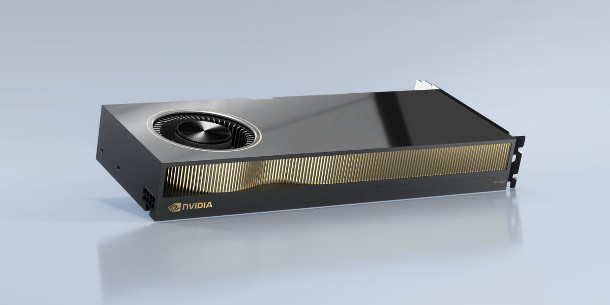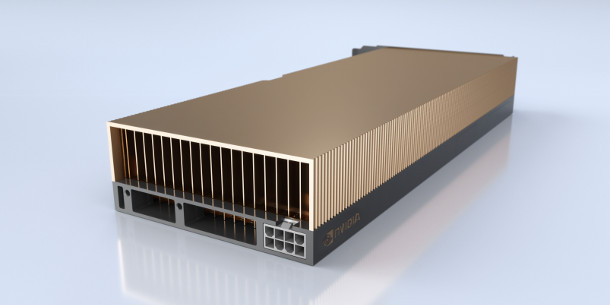Nvidia unveils new RTX A6000 and A40 pro Ampere GPUs

Nvidia has unveiled the RTX A6000 (shown above) and RTX A40, the firm’s first professional GPUs to use its new Ampere architecture, during its GTC 2020 online conference.
The RTX A6000 – initially referred to as the Quadro RTX A6000, and due to ship later this year – supersedes Nvidia’s existing Turing-based Quadro RTX 6000 and Quadro RTX 8000 workstation cards.
Nvidia claims that compatible GPU-based renderers perform 2-3x better with it than with the Turing cards.
The RTX A40 is a passively cooled version of the A600, intended for use in servers, and due to ship in 2021. Nvidia hasn’t announced prices for either GPU yet.
The first workstation GPUs to use Nvidia’s Ampere architecture
The RTX A6000 and A40 are Nvidia’s first professional cards to use the Ampere architecture, following the announcement of the consumer-level GeForce RTX 3090, 3080 and 3070 last month.
Unlike with the current Turing architecture, and its dedicated RT ray tracing cores, Nvidia hasn’t introduced any new hardware types ths time round, though the designs of the existing cores have been updated.
Nvidia describes the Ampere cards’ second-gen RT cores as having 1.7x the throughput of their predecessors; and their third-gen Tensor machine learning cores as a 2.7x improvement.
| Nvidia workstation GPUs | ||||
|---|---|---|---|---|
| RTX A6000 | RTX A40 | Quadro RTX 8000 | Quadro RTX 6000 | |
| Architecture | Ampere | Ampere | Turing | Turing |
| CUDA cores | 10,752 | 10,752 | 4,608 | 4,608 |
| Tensor cores | 336 | 336 | 576 | 576 |
| RT cores | 84 | 84 | 72 | 72 |
| FP32 compute performance | 40.0 Tflops* | TBC | 16.3 Tflops | 16.3 Tflops |
| GPU memory | 48GB GDDR6 |
48GB GDDR6 |
48GB GDDR6 |
24GB GDDR6 |
| Memory bandwidth | 768 GB/s | 696 Gb/s | 672 GB/s | 672 GB/s |
| NVLink | Yes | Yes | Yes | Yes |
| Graphics bus | PCIe 4.0 x16 | PCIe 4.0 x16 | PCIe 3.0 x16 | PCIe 3.0 x16 |
| TDP | 300W | 300W | 295W | 295W |
| Display connectors | 4 x DisplayPort 1.4 | 3 x DisplayPort 1.4 | 4 x DisplayPort 1.4 | 4 x DisplayPort 1.4 |
| Launch date | 2020 | 2021 | 2018 | 2018 |
| Launch price | TBC | TBC | $9,999 | $6,299 |
*Figure comes from third-party website
Similar core specifications to the current top-of-the-range Quadro RTX 8000
In terms of other core specs, the RTX A6000 sticks pretty closely to the formula established by the Quadro RTX A8000.
Both feature 48GB of on-board GDDR6 memory, NVLink support, and four DisplayPort 1.4 outputs, and have similar maximum power consumption.

The RTX A40 (above) is a passively cooled version of the A6000 – that is, lacking a built-in fan – designed for use in servers and digital signage.
According to Nvidia, it has three DisplayPort ports, not four, and its GPU compute performance is “slightly down” on the A6000, but otherwise, its specs are identical.
Twice the GPU rendering speed of the Turing cards?
Nvidia claims that compatible GPU renderers perform around 2-3x better with the RTX A6000 than with the Turing cards it supersedes.
In its blog post announcing the new cards, the firm says that the RTX A6000’s score in the built-in benchmark in the upcoming KeyShot 10 is “almost triple” that of the Quadro RTX 6000.
The Ampere architecture also “more than double[s]” the performance of Chaos Group’s V-Ray GPU and Project Lavina, although that’s based on the GeForce RTX 3080, not the A6000 itself.
Nvidia also quotes Digital Domain CG supervisor Bob White as saying that the studio had achieved a “2x performance increase with Redshift“, although it didn’t specify with which GPUs.
Pricing and release dates
The RTX A6000 will be available in mid December. The A40 will be available via workstation and server vendors early next year. Nvidia hasn’t announced prices yet.
